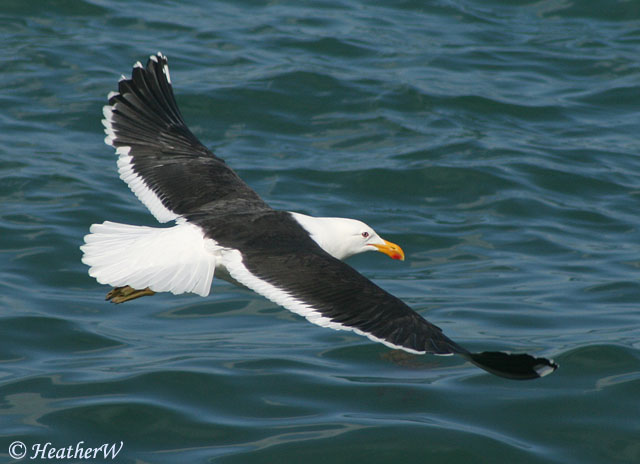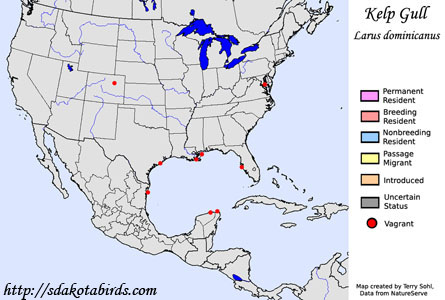| Length: 24 inches | Wingspan: 55 inches | Seasonality: Non-resident in South Dakota |
| ID Keys: Very dark mantle, completely white body, head, and tail, yellow bill with red spot, pale yellowish to greenish-yellow legs | ||
 The
Kelp Gull has a wide geographic distribution, with populations found in
Australia, Africa, and South America. In North America, they are rare
visitors, with most records around the Gulf Coast. There have been
rare and scattered breeding records north of their normal range, including
one from coastal islands off of Louisiana. They are a species that can
be difficult to distinguish from some of the more common North American
species, such as the Lesser
Black-backed and Great
Black-backed Gulls, but the Kelp Gull is considered to have the darkest
mantle color of all of our gull species.
The
Kelp Gull has a wide geographic distribution, with populations found in
Australia, Africa, and South America. In North America, they are rare
visitors, with most records around the Gulf Coast. There have been
rare and scattered breeding records north of their normal range, including
one from coastal islands off of Louisiana. They are a species that can
be difficult to distinguish from some of the more common North American
species, such as the Lesser
Black-backed and Great
Black-backed Gulls, but the Kelp Gull is considered to have the darkest
mantle color of all of our gull species.
Habitat: Found around coastlines, not pelagic as some gull species. They can be found in a variety of coastal habitats, as well as some inland habitats along major water bodies and rivers.
Diet: Omnivorous, with food items including fish, crustaceans, mollusks, marine worms, insects, eggs, young birds, small rodents, and carrion and refuse.
Behavior: Uses a variety of foraging techniques depending upon location and food item. They will follow fishing vessels and other ships for offal and scraps, and will also visit areas such as garbage dumps for refuse.
Nesting: A colonial nester. The nest is built in rocky areas, on sandy shores, or among wetland vegetation, and is a large structure built of seaweed and other vegetation. The female usually lays 2 or 3 eggs, and both parents help to incubate them. Both parents help raise the young after the eggs hatch.
Song: Has a hoarse kee-wah call.
Migration: Most populations of Kelp Gull are considered to be relatively sedentary, with little consistent migration. However, some birds at the far southern edge of their breeding ranges in the southern Hemisphere may move northward for the winter.
Interactive eBird map: Click here to access an interactive eBird map of Kelp Gull sightings
Similar Species: Lesser Black-backed Gull, Yellow-footed Gull, Great Black-backed Gull.
Conservation Status: Populations are very large and appear to be increasing, and they are found over a wide geographic area. The IUCN lists the Kelp Gull as a species of "Least Concern".
Further Information: 1) WhatBird.com - Kelp Gull
2) BirdLife International - Kelp Gull
3) ARKIVE.org - Kelp Gull
Photo Information: Photo taken by HeatherW - Photo licensed under Creative Commons Attribution NonCommercial 2.0 Generic License.
| Click below for a higher-resolution map |
 |
| South Dakota Status: Non-resident in South Dakota |
Additional Kelp Gull Photos (coming soon!!)
